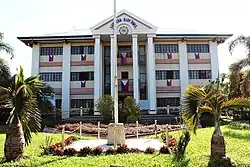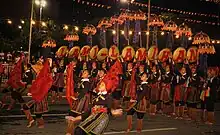Lamitan
لميتن | |
|---|---|
| City of Lamitan | |
 Lamitan City Hall | |
 Flag  Seal | |
| Motto(s): Lamitan Kong Mahal (Lamitan, My Love) | |
 Map of Basilan with Lamitan highlighted | |
OpenStreetMap | |
.svg.png.webp) Lamitan Location within the Philippines | |
| Coordinates: 6°39′N 122°08′E / 6.65°N 122.13°E | |
| Country | |
| Region | |
| Province | Basilan |
| District | Lone district |
| Founded | 1886 |
| Cityhood | June 8, 2007 (Lost cityhood in 2008 and 2010) |
| Affirmed Cityhood | February 15, 2011 |
| Barangays | 45 (see Barangays) |
| Government | |
| • Type | Sangguniang Panlungsod |
| • Mayor | Roderick H. Furigay |
| • Vice Mayor | Hegem C. Furigay |
| • Representative | Mujiv S. Hataman |
| • City Council | Members |
| • Electorate | 50,134 voters (2022) |
| Area | |
| • Total | 354.45 km2 (136.85 sq mi) |
| Elevation | 118 m (387 ft) |
| Highest elevation | 996 m (3,268 ft) |
| Lowest elevation | 0 m (0 ft) |
| Population (2020 census)[3] | |
| • Total | 100,150 |
| • Density | 280/km2 (730/sq mi) |
| • Households | 19,353 |
| Economy | |
| • Income class | 6th city income class |
| • Poverty incidence | 52.71 |
| • Revenue | ₱ 664.1 million (2020) |
| • Assets | ₱ 16,895 million (2020) |
| • Expenditure | ₱ 588.5 million (2020) |
| • Liabilities | ₱ 839 million (2020) |
| Service provider | |
| • Electricity | Basilan Electric Cooperative (BASELCO) |
| Time zone | UTC+8 (PST) |
| ZIP code | 7302 |
| PSGC | |
| IDD : area code | +63 (0)62 |
| Native languages | Chavacano Yakan Tagalog |
| Website | https://lamitancity.gov.ph/ |
Lamitan, officially the City of Lamitan (Chavacano: Ciudad de Lamitan; Yakan: Siyudad Lamitanin; Tausūg: Dāira sin Lamitan; Filipino: Lungsod ng Lamitan), is a 6th class component city and de jure capital of the province of Basilan, Philippines. According to the 2020 census, it has a population of 100,150 people.[3]
The city is bounded on the east by the municipality of Tuburan, on the south by Tipo-Tipo, on the west by Isabela and on the north by Basilan Strait.
In July 2016, the Basilan provincial government broke ground for the construction of the new provincial capitol inside the defunct 4,000-hectare (9,900-acre) University of the Philippines (UP) Land Grant in Barangay Santa Clara.[5]
In July 2022, Lamitan gained national attention when former mayor Rose Furigay, who had served as the city's mayor from 2013 to June 2022, was assassinated in a mass shooting at the Ateneo de Manila University where two others were killed.[6]
History
Cityhood

On June 18, 2007, voters in Lamitan ratified Republic Act No. 9393. 26,636 voted "yes," while only 177 voted against.
The Supreme Court declared the cityhood law of Lamitan and 15 other cities unconstitutional after a petition filed by the League of Cities of the Philippines in its ruling on November 18, 2008. On December 22, 2009, the cityhood law of Lamitan and 15 other municipalities regain its status as cities again after the court reversed its ruling on November 18, 2008. On August 23, 2010, the court reinstated its ruling on November 18, 2008, causing Lamitan and 15 cities to become regular municipalities. Finally, on February 15, 2011, Lamitan becomes a city again including the 15 municipalities declaring that the conversion to cityhood met all legal requirements.
After six years of legal battle, in its board resolution, the League of Cities of the Philippines acknowledged and recognized the cityhood of Lamitan and 15 other cities.
Geography
The terrain is relatively plain along the coastal areas and hilly in some areas. The urban area is 2.5 meters (8 ft 2 in) above sea level and gently sloping to 300 meters (980 ft) toward the hinterlands.
Barangays
Lamitan is politically subdivided into 45 barangays. Each barangay consists of puroks while some have sitios.
- Arco
- Ba-as
- Baimbing
- Balagtasan
- Balas
- Balobo
- Bato
- Boheyakan
- Buahan
- Boheibu
- Bohesapa
- Bulingan
- Cabobo
- Campo Uno
- Colonia
- Calugusan
- Kulay Bato
- Limo-ok
- Lo-ok
- Lumuton
- Luksumbang
- Malo-ong Canal
- Malo-ong San Jose
- Parangbasak
- Santa Clara
- Tandong Ahas
- Tumakid
- Ubit
- Bohebessey
- Baungos
- Danit-Puntocan
- Sabong
- Sengal
- Ulame
- Bohenange
- Boheyawas
- Bulanting
- Lebbuh
- Maganda (Poblacion)
- Malakas (Poblacion)
- Maligaya (Poblacion)
- Malinis (Poblacion)
- Matatag (Poblacion)
- Matibay (Poblacion)
- Simbangon
Climate
| Climate data for Lamitan, Basilan | |||||||||||||
|---|---|---|---|---|---|---|---|---|---|---|---|---|---|
| Month | Jan | Feb | Mar | Apr | May | Jun | Jul | Aug | Sep | Oct | Nov | Dec | Year |
| Mean daily maximum °C (°F) | 27 (81) |
27 (81) |
27 (81) |
28 (82) |
28 (82) |
28 (82) |
28 (82) |
28 (82) |
28 (82) |
28 (82) |
28 (82) |
28 (82) |
28 (82) |
| Mean daily minimum °C (°F) | 27 (81) |
26 (79) |
27 (81) |
27 (81) |
28 (82) |
28 (82) |
27 (81) |
27 (81) |
27 (81) |
27 (81) |
27 (81) |
27 (81) |
27 (81) |
| Average precipitation mm (inches) | 106 (4.2) |
77 (3.0) |
91 (3.6) |
104 (4.1) |
236 (9.3) |
321 (12.6) |
325 (12.8) |
306 (12.0) |
227 (8.9) |
271 (10.7) |
204 (8.0) |
115 (4.5) |
2,383 (93.7) |
| Average rainy days | 15.3 | 13.8 | 17.7 | 15.5 | 23.1 | 24.5 | 24.3 | 24.6 | 21.1 | 22.9 | 20.1 | 16.6 | 239.5 |
| Source: Meteoblue (modeled/calculated data, not measured locally)[7] | |||||||||||||
The climatic condition is the same with other areas in the entire Basilan Island. It has a "D" type of climate and rainfall is evenly distributed throughout the year.
Demographics

|
| |||||||||||||||||||||||||||||||||||||||
| Source: Philippine Statistics Authority[8][9][10][11] | ||||||||||||||||||||||||||||||||||||||||
Economy
.jpg.webp)
Historical sites

- Datu Kalun Shrine – Built as a tribute to a famous Yakan leader and founder of Lamitan. His descendants are the Antonio-Cuevas-Pamaran-Flores clan.
- Museum of Lamitan – Showcases the color and highlights of the Lami-lamihan festival. It also serves as the information center for the development of this town.
Education
Tertiary
Lamitan is home to one state college and three private colleges. The Basilan State College is an extension college of the main SUC in Isabela. The three HEIs are the Mindanao Autonomous College, the Mariam School of Nursing and Furigay Colleges, Inc. (FCI).
The Mariam School of Nursing was established in 2004 as part of its Chairwoman's educational outreach program and was named Mariam or Mother Mary - a unifying and guiding figure among the Christians and Muslims. Also offers 11 Tesda Qualifications for National Certificates.
Secondary
Lamitan has Seven Secondary Schools: one Private Secondary School; The Claret School of Lamitan, one Laboratory School of Basilan State College and five National High Schools i.e. Lamitan National High School, Look National High School,Colony National High School,Ubit National High School and Parangbasak National High School.
Elementary
There are five districts that composed of thirty nine elementary schools namely; Lamitan East District, South District, Central District, West I District and West II District. There are four private elementary schools.
References
- ↑ City of Lamitan | (DILG)
- ↑ "2015 Census of Population, Report No. 3 – Population, Land Area, and Population Density" (PDF). Philippine Statistics Authority. Quezon City, Philippines. August 2016. ISSN 0117-1453. Archived (PDF) from the original on May 25, 2021. Retrieved July 16, 2021.
- 1 2 Census of Population (2020). "Bangsamoro (BARMM)". Total Population by Province, City, Municipality and Barangay. Philippine Statistics Authority. Retrieved July 8, 2021.
- ↑ "PSA Releases the 2018 Municipal and City Level Poverty Estimates". Philippine Statistics Authority. December 15, 2021. Retrieved January 22, 2022.
- ↑ "ARMM to put up new Basilan capitol". The Philippine STAR.
- ↑ "Former Lamitan mayor, two others killed in Ateneo shooting". GMA News. July 24, 2022. Archived from the original on July 25, 2022. Retrieved July 24, 2022.
- ↑ "Lamitan, Basilan : Average Temperatures and Rainfall". Meteoblue. Retrieved January 29, 2019.
- ↑ Census of Population (2015). "ARMM – Autonomous Region in Muslim Mindanao". Total Population by Province, City, Municipality and Barangay. Philippine Statistics Authority. Retrieved June 20, 2016.
- ↑ Census of Population and Housing (2010). "ARMM – Autonomous Region in Muslim Mindanao" (PDF). Total Population by Province, City, Municipality and Barangay. National Statistics Office. Retrieved June 29, 2016.
- ↑ Censuses of Population (1903–2007). "ARMM – Autonomous Region in Muslim Mindanao". Table 1. Population Enumerated in Various Censuses by Province/Highly Urbanized City: 1903 to 2007. National Statistics Office.
{{cite encyclopedia}}: CS1 maint: numeric names: authors list (link) - ↑ "Province of Basilan". Municipality Population Data. Local Water Utilities Administration Research Division. Retrieved December 17, 2016.
- ↑ "Poverty incidence (PI):". Philippine Statistics Authority. Retrieved December 28, 2020.
- ↑ "Estimation of Local Poverty in the Philippines" (PDF). Philippine Statistics Authority. November 29, 2005.
- ↑ "2003 City and Municipal Level Poverty Estimates" (PDF). Philippine Statistics Authority. March 23, 2009.
- ↑ "City and Municipal Level Poverty Estimates; 2006 and 2009" (PDF). Philippine Statistics Authority. August 3, 2012.
- ↑ "2012 Municipal and City Level Poverty Estimates" (PDF). Philippine Statistics Authority. May 31, 2016.
- ↑ "Municipal and City Level Small Area Poverty Estimates; 2009, 2012 and 2015". Philippine Statistics Authority. July 10, 2019.
- ↑ "PSA Releases the 2018 Municipal and City Level Poverty Estimates". Philippine Statistics Authority. December 15, 2021. Retrieved January 22, 2022.
